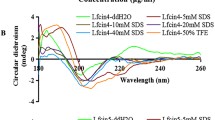Summary
Highly refined, disaggregated endotoxic glycolipids (B5) from heptose-less (Re) mutant Salmonella typhimurium quantitatively converted to nontoxic (lethality for chick embryos) and nonpyrogenic (fever in rabbits) lipid A by treatment with boiling 0.1 N HCl (B5-HC1). Nontoxic B5-HCl, like toxic B5, caused regression of line-10 tumors and elimination of lymph node metastasis in 27 of 32 (84%) syngeneic strain 2 guinea pigs at a dosage of 150 μg. At this dosage, toxic B5 led to a cure in 54 of 67 (81%) tumor-bearing animals. All cured animals rejected a second line-10 tumor cell transplant. This activity depended on combining the toxic or nontoxic endotoxins with mycobacterial trehalose mycolate (P3) and an essentially nontoxic peptide-containing side-fraction (ACP) recovered during the isolation of B5. In contrast to toxic B5 or endotoxins in general, nontoxic B5-HCl did not cause endotoxic shock when combined with adjuvant dipeptide (MDP) and injected IV into guinea pigs. Chemical analysis showed that the phosphate content of nontoxic B5-HCl was about one-half that observed in toxic B5 or in toxic KDO-free lipid A, which was obtained by treating toxic B5 with sodium acetate at pH 4.5 at 100° C (B5-pH 4.5). The molar ratio of glucosamine: phosphorus: fatty acids was 2:1:4 for nontoxic B5-HCl and was 2:2:4 for toxic B5-pH 4.5. These results demonstrate that endotoxic extracts could be selectively detoxified while retaining antitumor properties. Thus, nontoxic B5-HCl may be a potential candidate for immunotherapy of human cancer.
Similar content being viewed by others
References
Azuma I, Ribi E, Meyer TJ, Zbar B (1974) Biologically active components from mycobacterial cell walls. I. Isolation and composition of cell wall skeleton and component P3. J Natl Cancer Inst 52:95
Galanos C, Lüderitz O, Westphal O (1969) A new method for the extraction of R lipopolysaccharides. Eur J Biochem 9:245
Haskins WT, Landy M, Milner KC, Ribi E (1961) Biological properties of parent endotoxins and lipoid fractions, with a kinetic study of acid hydrolyzed endotoxin. J Exp Med 114:665
Joiner KA, Wolff SM (1981) The role of endotoxin in human disease and its therapy. In: Augmenting agents in cancer therapy. Raven Press, New York, p 125
Lowry OH, Roberts NR, Leiner KW, Wu M-L, Farr AL (1954) The quantitative histochemistry of brain. I. Chemical methods. J Biol Chem 207:1
Meyer TJ, Ribi E, Azuma I, Zbar B (1974) Biologically active components from mycobacterial cell walls. II. Suppression and regression of strain 2 guinea pig hepatoma. J Natl Cancer Inst 52:103
Milner KC, Finkelstein RA (1966) Bioassay of endotoxin: Correlation between pyrogenicity for rabbits and lethality for chick embryos. J Infect Dis 116:529
Milner KC, Rudbach JA, Ribi E (1971) Microbial toxins. A comprehensive treatise. In: Bacterial endotoxins, vol IV. Academic Press, New York, p 1
Nowotny A (1963) Relation of structure to function in bacterial antigens. II. Fractionation of lipids present in Boivin-type endotoxin of Serratia marcescens. J Bacteriol 85:427
Osborn MJ (1963) Studies on the gram-negative cell wall. I. Evidence for the role of 2-keto-3-deoxyoctonate in the lipopolysaccharide of Salmonella typhimurium. Proc Natl Acad Sci USA 50:499
Rapp HJ (1973) A guinea pig model for tumor immunology. A summary. Isr J Med Sci 9:366
Ribi E, Haskins WT, Landy M, Milner KC (1961) Preparation and host-reactive properties of endotoxin with low content of nitrogen and lipid. J Exp Med 114:647
Ribi E, Anacker RL, Brown R, Haskins WT, Malmgren B, Milner KC, Rudbach JA (1966) Reaction of endotoxin and surfactants. I. Physical and biological properties of endotoxin treated with sodium deoxycholate. J Bacteriol 92:1493
Ribi E, Parker R, Milner KC (1974) Microparticulate gel chromatography accelerated by centrifugal force and pressure. Methods Biochem Anal 22:355
Ribi E, Granger DL, Milner KC, Strain SM (1975) Brief communication: Tumor regression caused by endotoxins and mycobacterial fractions. J Natl Cancer Inst 55:1253
Ribi E, Takayama K, Milner KC, Gray GR, Goren M, Parker R, McLaughlin CA, Kelly M (1976) Regression of tumors by an endotoxin combined with trehalose mycolate of differing structure. Cancer Immunol Immunother 1:265
Ribi E, Cantrell JL, Von Eschen K, Schwartzman S (1979a) Enhancement of endotoxic shock by adjuvant dipeptide (MDP). Cancer Res 39:4756
Ribi E, Parker R, Strain SM, Mizuno Y, Nowotny A, Von Eschen KB, Cantrell JL, McLaughlin CA, Hwang KM, Goren MB (1979b) Peptides as requirement for immunotherapy of the guinea pig line-10 tumor with endotoxins. Cancer Immunol Immunother 7:43
Rietschel ET, Galanos C, Tanaka A, Ruschmann E, Lüderitz O, Westphal O (1971) Biological activities of chemically modified endotoxins. Eur J Biochem 22:218
Rosner MR, Tang JY, Barzilay I, Khorana HG (1979) Structure of the lipopolysaccharide from Escherichia coli heptose-less mutant. J Biol Chem 254:5906
Schwartzman SM, Ribi E (1980) A shortened synthesis of adjuvant peptide (MDP). Prep Biochem 10:255
Takayama K, Ribi E, Cantrell JL (1981) Isolation of a nontoxic lipid A fraction containing tumor regressive activity. Cancer Res 41:2654
Westphal O, Lüderitz O (1954) Chemische Erforschung von lipopolysacchariden gramnegativen Bakterien. Angew Chem 66:407
Author information
Authors and Affiliations
Additional information
Abbreviations used in this paper: ACP, a nontoxic acetone-chloroform precipitated side-fraction of endotoxin that contains (an) ingredient(s) necessary for tumor regression of line-10 tumors in strain 2 guinea pigs; ReGl, endotoxic glycolipids from Re mutant gram-negative bacteria; ReGl-PCP, ReGl extracted with phenol-chloroform-petroleum ether (PCP); B5, refined endotoxin, free of phospholipids, divalent cations and disaggregated; B5-HCl, nontoxic lipid A prepared from B5 by treatment with hydrochloric acid; B5-pH 4.5, toxic lipid A prepared from B5 by treatment with sodium acetate at pH 4.5; lipid A, hydrochloric acid or sodium acetate hydrolysate of ReGl-PCP or B5; MDP, N-acetyl-muramyl-l-seryl-d-isoglutamine; KDO, keto-3-deoxyoctonate
Rights and permissions
About this article
Cite this article
Ribi, E., Amano, K., Cantrell, J. et al. Preparation and antitumor activity of nontoxic lipid A. Cancer Immunol Immunother 12, 91–96 (1982). https://doi.org/10.1007/BF00205365
Received:
Accepted:
Issue Date:
DOI: https://doi.org/10.1007/BF00205365




